AMD A10-7800 Review: Testing the A10 65W Kaveri
by Ian Cutress on July 31, 2014 8:00 AM ESTCPU Benchmarks
The dynamics of CPU Turbo modes, both Intel and AMD, can cause concern during environments with a variable threaded workload. There is also an added issue of the motherboard remaining consistent, depending on how the motherboard manufacturer wants to add in their own boosting technologies over the ones that Intel would prefer they used. In order to remain consistent, we implement an OS-level unique high performance mode on all the CPUs we test which should override any motherboard manufacturer performance mode.
HandBrake v0.9.9: link
For HandBrake, we take two videos (a 2h20 640x266 DVD rip and a 10min double UHD 3840x4320 animation short) and convert them to x264 format in an MP4 container. Results are given in terms of the frames per second processed, and HandBrake uses as many threads as possible.
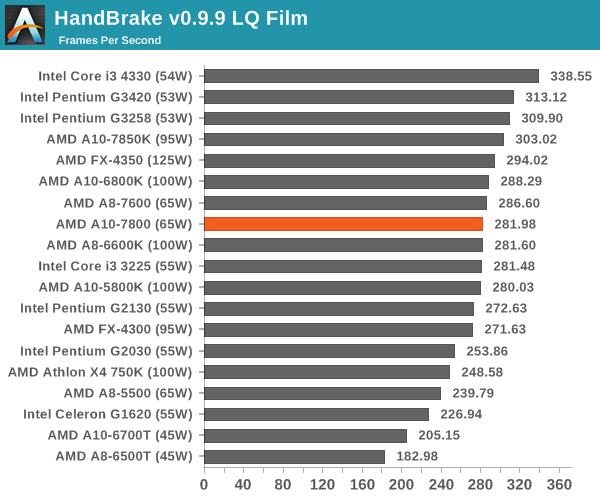
The latest Intel processors have the lead for low quality Handbrake conversion, and despite the generational gap between the FX-4350 and the A10-7800, the extra MHz is preferred here.

For large frame manipulation, the latest architectures mixed with the most threads perform best.
Agisoft Photoscan – 2D to 3D Image Manipulation: link
Agisoft Photoscan creates 3D models from 2D images, a process which is very computationally expensive. The algorithm is split into four distinct phases, and different phases of the model reconstruction require either fast memory, fast IPC, more cores, or even OpenCL compute devices to hand. Agisoft supplied us with a special version of the software to script the process, where we take 50 images of a stately home and convert it into a medium quality model. This benchmark typically takes around 15-20 minutes on a high end PC on the CPU alone, with GPUs reducing the time.
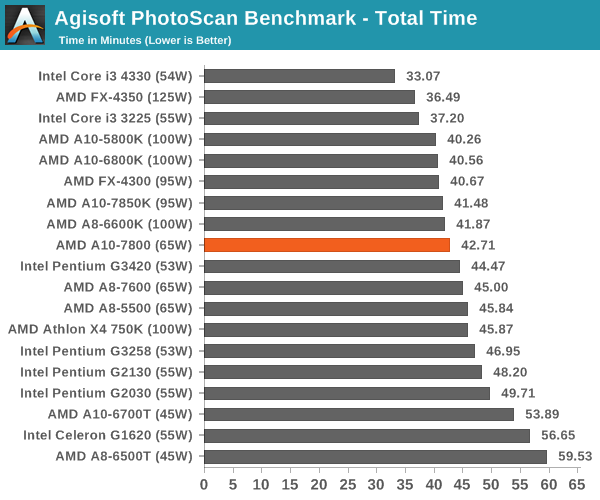
Dolphin Benchmark: link
Many emulators are often bound by single thread CPU performance, and general reports tended to suggest that Haswell provided a significant boost to emulator performance. This benchmark runs a Wii program that raytraces a complex 3D scene inside the Dolphin Wii emulator. Performance on this benchmark is a good proxy of the speed of Dolphin CPU emulation, which is an intensive single core task using most aspects of a CPU. Results are given in minutes, where the Wii itself scores 17.53 minutes.
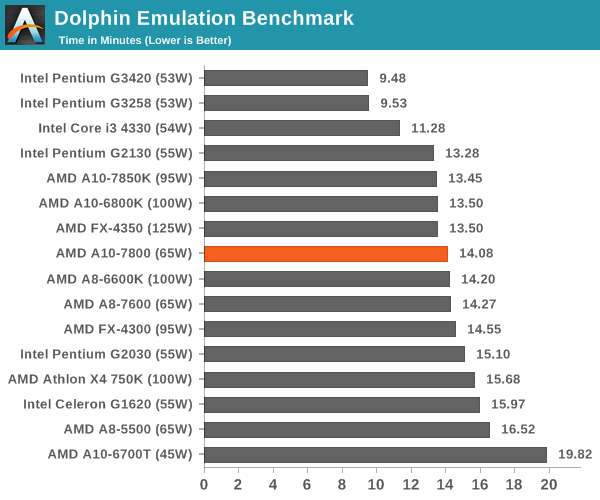
Dolphin seems to work best with high single core speed and Haswell.
WinRAR 5.0.1: link
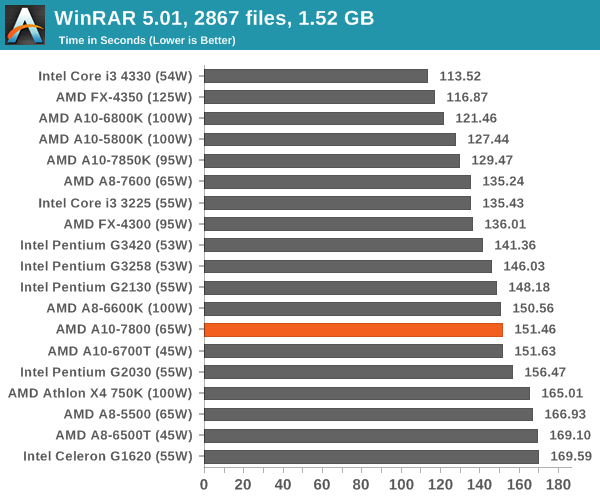
PCMark8 v2 OpenCL on IGP
A new addition to our CPU testing suite is PCMark8 v2, where we test the Work 2.0 and Creative 3.0 suites in OpenCL mode. As this test is new, we have not run it on many AMD systems yet and will do so as soon as we can.
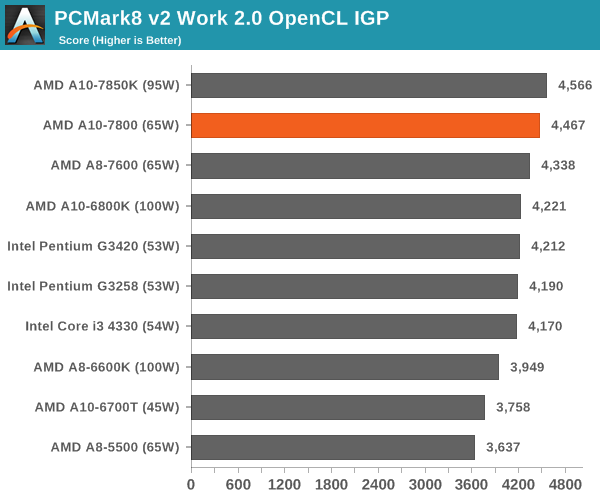
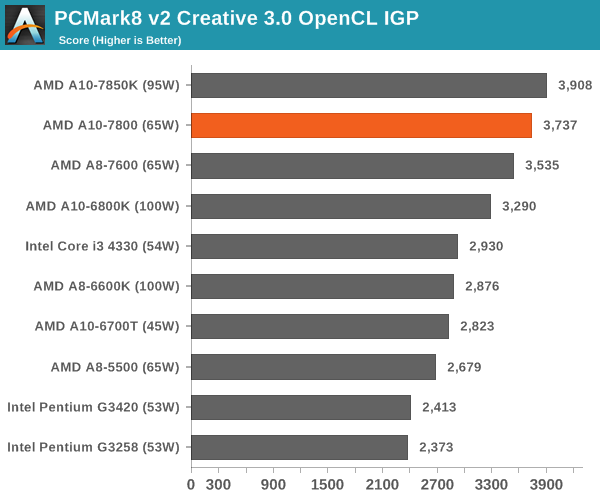
The combination of processor graphics and OpenCL support push the AMD APUs up to the top of our PCMark tests.
Hybrid x265
Hybrid is a new benchmark, where we take a 4K 1500 frame video and convert it into an x265 format without audio. Results are given in frames per second.
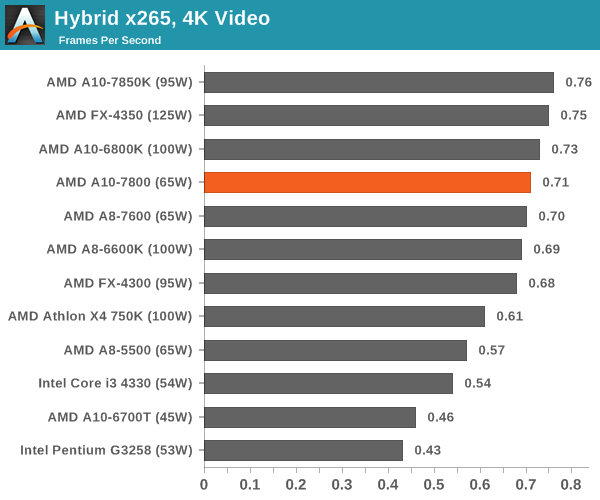
Cinebench R15


Cinebench is typically Intel territory for high IPC processors, but when it comes to multithreaded rendering, extra threads help.
3D Particle Movement
3DPM is a self-penned benchmark, taking basic 3D movement algorithms used in Brownian Motion simulations and testing them for speed. High floating point performance, MHz and IPC wins in the single thread version, whereas the multithread version has to handle the threads and loves more cores.
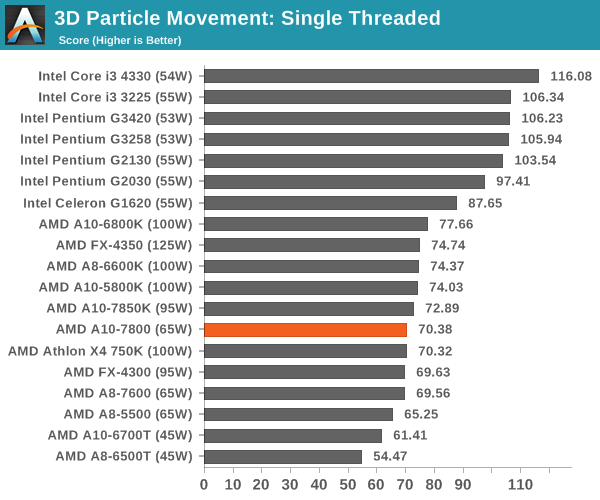
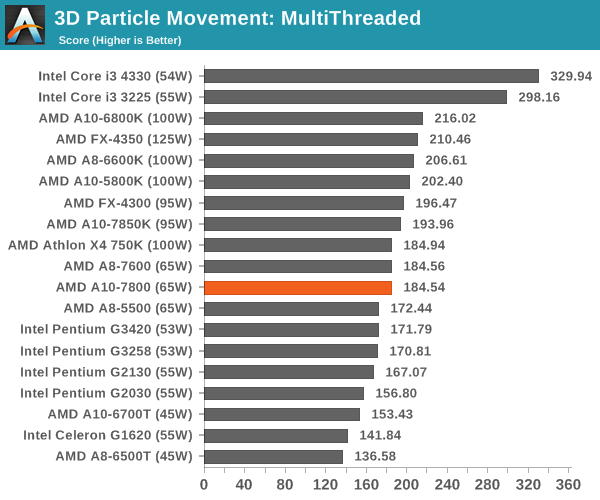
All the calculations in 3DPM deal with floating point numbers, a known sink for AMD compute.
FastStone Image Viewer 4.9
FastStone is the program I use to perform quick or bulk actions on images, such as resizing, adjusting for color and cropping. In our test we take a series of 170 images in various sizes and formats and convert them all into 640x480 .gif files, maintaining the aspect ratio. FastStone does not use multithreading for this test, and results are given in seconds.
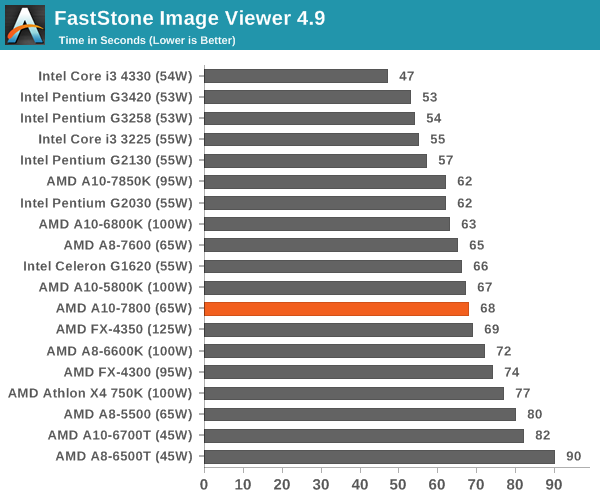
Web Benchmarks
On the lower end processors, general usability is a big factor of experience, especially as we move into the HTML5 era of web browsing. For our web benchmarks, we take four well known tests with Chrome 35 as a consistent browser.
Sunspider 1.0.2

Mozilla Kraken 1.1
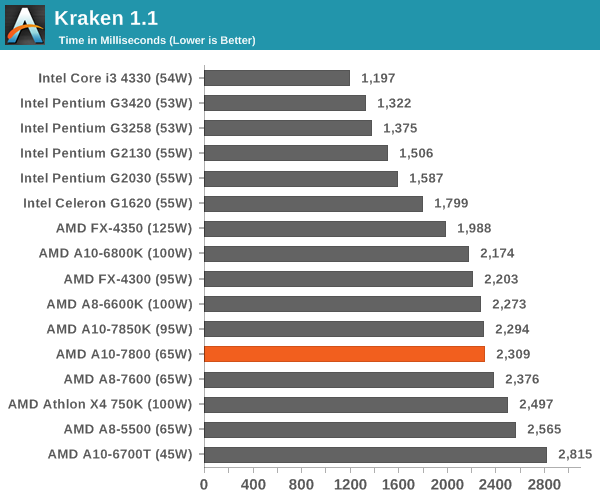
WebXPRT
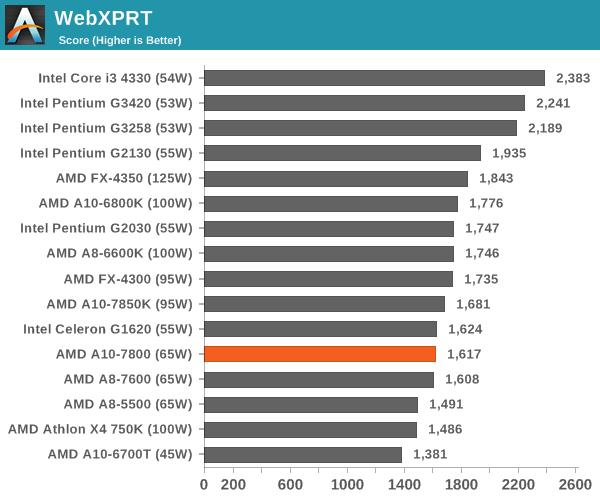
Google Octane v2
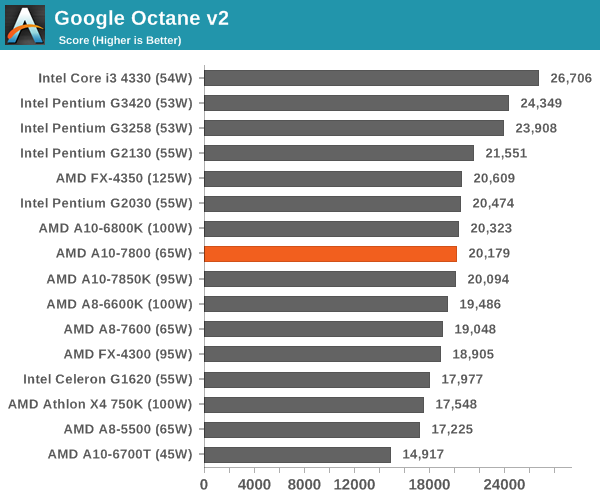










147 Comments
View All Comments
eanazag - Thursday, July 31, 2014 - link
A real budget Desktop PC based on AMD for gaming is going to be the A8-7600. The performance numbers are so close and the processor is also ~$100. The pricing on the 7850K doesn't make sense. The 7800 begins to get reasonable. The A88X chipset is a smidge better than the H87 from a feature standpoint. I think the 7850K should be around $145 and the 7800 around $125. Yes, AMD would take a hit on margin, but I think the volume could be better.tomsworkshop - Thursday, July 31, 2014 - link
the 65W TDP A10-7800 & A8-7600 are good enough for day to day computing + gaming,the intel-i5 may give u 2.5% more performance for the extra 25% cost for day to day computing but not for gaming, u still need to spend more for the dGPU if u wanna games, but that means the cost, TDP, heat & noise and your power bill will be increasing as well.
Andrew Lin - Tuesday, August 5, 2014 - link
again, i don't actually see what you're trying to say here. the system power usage of almost any intel i3 or i5 are a good amount lower than almost anything AMD has, and that's with far higher performance. the same argument about the dGPU can be made about AMD, but with worth propositions because then you've actually bought an APU for absolutely no reason.Andrew Lin - Tuesday, August 5, 2014 - link
that should say "worse propositions"tomsworkshop - Thursday, August 14, 2014 - link
again, we use both Intel CPU (without discrete GPU) and AMD APU here, we see no big different on applications which need a lot computing power, maybe a few second faster on the Intel system, but we see a big different for application that need a lot of graphic power, AMD APU shine on that area. the average joe that buy an system for day to day computing like online, office document, video playback, online games don't even need to computing power from the i5/i7, the core 2 duo or even Pentium 4 can be satisfy for them, you've actually bought an i5/i7 for absolutely no reason.tomsworkshop - Thursday, August 14, 2014 - link
because you are too stupid to understand and see the different or you just a plain blind Intel fanboy sheep, we all know that Intel CPU alone had little bit lower TDP than AMD offering, but the integratedGPU on the Intel CPU sucks big times, anyone in the right mind who build Intel system for gaming will sure need a discrete graphic card by geforce or by radeon, than it totally makes the Intel systems TDP far higher than current AMD 45W/65W APU, we already see that the 45W/65W A8-7600 can handle many modern games on medium setting, that pretty amazing for building a cybercafe gaming rigs, the owner with 50-100 units gaming rig build with AMD 45/W/65W APU will make profit and save money from cut down a lot power cost, the single chip AMD APU will also produce less heat than the intel cpu + discrete gpu, less heat in the cybercafe means less air condition needed = less power = cost saving, the single chip AMD APU will also produce less noise than the intel cpu + discrete gpu, less noise in the cybercafe lead to better environment quality for the cybercafe, that's make the big different which the kids like you can even see.max1001 - Thursday, July 31, 2014 - link
Why in the world would someone buy an APU to get dGPU?tomsworkshop - Thursday, July 31, 2014 - link
lower power consumption, less noise and heat, small form factor, console size gaming rig and htpcJon Tseng - Friday, August 1, 2014 - link
Catch 22:1) AMD kicks ass if you want to game on integrated graphics only.
2) If care about gaming you'd never use integrated graphics only.
Therefore AMD's kickass integrated performance is only available people who don't care about gaming and don't need AMD's kickass integrated performance.
mrcaffeinex - Friday, August 1, 2014 - link
I own an A10-7850K and I game on the iGPU exclusively. I primarily play older titles, but the performance is there for what I'm playing: Skyrim, Fallout: New Vegas, Rage, even a little Battlefield 3 from time to time...1080p on high settings for older titles is not only playable on the iGPU, but gets 60 FPS on some titles. What more do you need for HTPC/light gaming duty?
I picked up the APU/Motherboard as a combo at MicroCenter for about $150 after tax. It fits in my slim HTPC case, runs cool (doesn't need the fan ramped up high enough to make it audible) and does what I need it to do.
The problem is that so many people become so focused on one single performance aspect that they overlook the myriad use-cases for these APUs, of which small-form-factor HTPCs are one. The A10-7800 is running the same iGPU with slightly lower-clocked CPU cores for less money, with a lower TDP, making them viable for even more consumers that do not have the need of a dGPU, but still want to do some casual gaming, which I bet encompasses a lot more people than the typically enthusiast crowd that frequents a site like Anandtech...